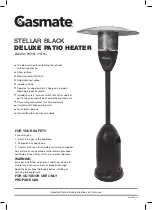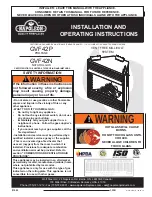
19
100792
AIR FOR
COMBUSTION
AND
VENTILATION
Continued
Figure 15 - Ventilation Air from Outdoors
IMPORTANT
Do not provide openings for inlet or outlet air into attic
if attic has a thermostat controlled power vent.
Chimney
or Gas
Vent
Outlet
Air
Ventilated
Attic
Outlet
Air
Inlet
Air
Inlet Air
Ventilated
Crawl Space
To
Crawl
Space
To Attic
Continued
Draft Hood Spillage:
This is a hazardous situation. Draft hood spillage re-
leases poisonous carbon monoxide gas into your home.
WARNING ICON
G 001
DANGER
Carbon monoxide poisoning may lead to death!
If draft hood spillage occurs, check for blocked flue connectors, vent pipes, and
chimneys. If you find blockage, remove. Test again for spillage. If spillage still
occurs or there was no blockage, you need more fresh, outside air in the house. You
must provide additional fresh-air ventilation. Follow the steps below at once.
A. Open a window near the appliance(s) at least two inches. Test again for
spillage. If spillage does not stop, open window more and retest. If spillage
stops, keep window open while running appliance(s). Supply fresh, outside
air by a permanent method as soon as possible. If spillage still occurs, leave
window open and go to next step.
B. If you have a fireplace, open a window or door near it at least two inches.
Test again for spillage. If spillage does not stop, open window or door more
and retest. If spillage stops, keep window or door open while using fire-
place. Supply fresh, outside air by a permanent method as soon as possible.
If spillage still occurs, leave window or door open and go to next step.
C. If you have kitchen and bathroom exhaust fans, turn them off. Test again for
spillage. If spillage stops, do not use exhaust fans. Turn off circuit breakers for
fans if possible. Permanently supply fresh, outside air as soon as possible.
Providing Permanent Fresh-Air Ventilation
If draft hood spillage occurs, you must permanently supply fresh, outside air to the
inside of your house. Provide extra fresh air by using ventilation grills or ducts.
Connect these items directly to the outdoors or spaces open to the outdoors. These
spaces include attics and crawl spaces. If you install this heater in an area with
other gas appliances, you must total the BTU/Hr input rating of all appliances.
Follow the National Fuel Gas Code NFPA 54/ANSI Z223.1. It lists fresh-air
requirements for fuel-burning appliances.
















































